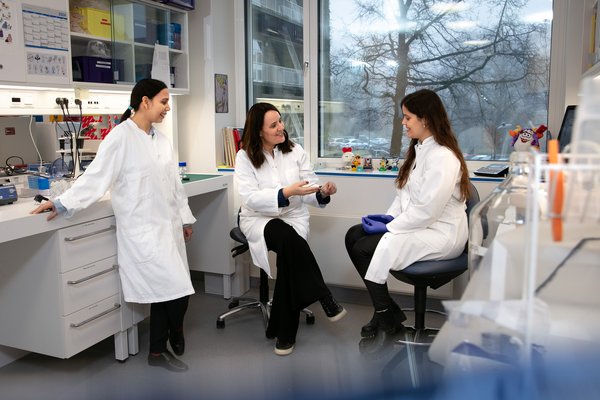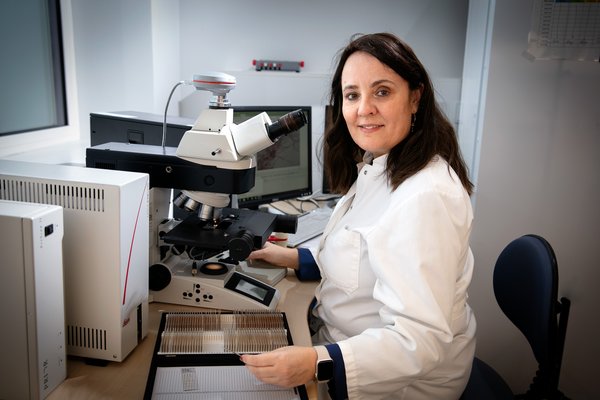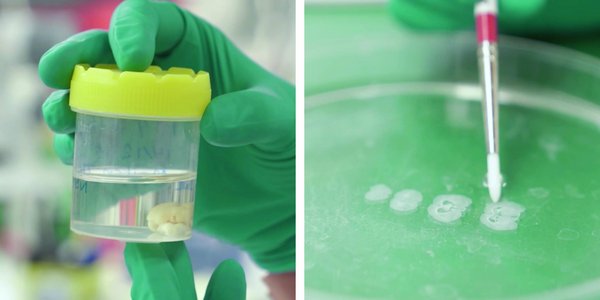Describing changes of the immune system in Parkinson’s disease to find new biomarkers and therapeutic targets
The IMPAD project aimed to identify blood biomarkers for Parkinson's disease. Read here how the IMPAD team approach this task.
”We’ve started out with the hypothesis that the immune system is involved in the development of Parkinson’s disease,” says Marina Romero-Ramos and continues: “That’s why we’ve investigated how the immune system changes at different stages of the disease and also between subtypes and across genders.”
Marina Romero-Ramos was heading the IMPAD project, which both aimed to define biomarkers in the blood of people with Parkinson’s disease and evaluate the translational potential of cellular and animal models used for mimicking Parkinson’s disease in humans. By doing so, the IMPAD project addressed a critical need for biomarkers for both diagnosis and for monitoring the progression of the disease.
Parkinson’s disease is characterized by degeneration of neurons
In Parkinson’s disease, a-synuclein, a protein in the brain, suddenly starts to aggregate and form larger structures called amyloid fibrils. a-synuclein normally plays a vital function in the brain, where it ensures that neurons can send signals to other neurons. However, when the protein begins to form fibrils inside a neuron, several cellular processes are disturbed and the neuron loses its function. Eventually it degenerates - it simply dies.
“The a-synuclein aggregates are formed inside many neurons in the brain and this affects their function. Among the neurons, those producing dopamine in the midbrain are especially susceptible. This is why Parkinson’s disease can be accurately diagnosed when the brain is scanned for dopamine activity. As the disease progresses the dopamine level becomes lower,” explains Marina Romero-Ramos.
This decrease of dopamine is associated to the well-known symptoms of Parkinson’s disease, such as the shaking of hands, the slow and rigid movements and poor balance. But the accumulation of fibrils in other neurons contribute to the many additional symptoms in the disease such as, constipation, depression, sleep problems, and dementia. In fact, these non-motor symptoms can appear earlier in the disease than the characteristic motor problems. As Marina Romero-Ramos clarifies: “The disease is in fact much more than a motor disorder. We should rather consider it a multisystem disorder where the immune system is also involved.”

Objectives and affordable parameters for diagnosis and follow-up are needed
Observation of the motor symptoms is the common strategy for the diagnosis and follow up of people with Parkinson’s disease. But this requires long clinical testing, and relies on the evaluation of many subjective parameters, both from the point of view of the patient, but also from the physician observing the patient.
Brain scans is an objective diagnostic method that can also be used to assess the loss of neuronal function in people with Parkinson’s disease, and hence how far the disease has progressed. However, this is both an expensive and time-consuming approach. Marina Romero-Ramos and the IMPAD team were thus keen on identifying objective biomarkers in the blood of people with Parkinson’s disease: “It only takes a few minutes to take a blood sample. It would be a huge step forward, if we can use blood samples to inform about the disease and its stage and better decide on the best therapy for each patient individually. We are also hoping that the blood sample can reveal novel targets for treating the disease - maybe even with already existing immune-related drugs,” she says.

Can the immune system affect how the progression of Parkinson’s disease occurs?
When looking for and evaluating the potential of biomarkers, in-depth knowledge of the disease is a huge advantage. Researchers already know much about the disease, but the exact cause of onset is still unknown. “Inflammation is often observed in the brain of people with Parkinson’s disease. We know that a-synuclein drives immune responses and that the involved immune cells can promote neuronal cell death,” explains Marina Romero-Ramos and elaborates further: “According to some theories, the a-synuclein aggregation starts when the nerve endings of either the vagus nerve or the olfactory nerve are exposed to stress, such as toxins or infections. Thi stress induces a-synuclein aggregation and fibrillar formation. This theory correlates well with the existence of two subtypes of Parkinson’s disease, recently proposed by Professor Per Borghammer. He proposes that one subtype starts in the nose and the other in the gut.”
Nerves potentially affected in Parkinson's disease
The vagus nerve connects the brain with several digestive organs and it has anti-inflammatory functions.
The olfactory nerve, which enbale the sense of smell, runs from the nose to brain (close to the amygdala area).
To understand how the vagus and olfactory nerves are related to the two disease subtypes, it’s important to know how the disease spreads between neurons. When the amyloid fibrils have formed within the first neuron affected in either the gut or the nose, some of the aggregated a-synuclein it is believed to be excreted from the cell and taken up by neighboring cells. In the healthy neurons, this small aggregate will function like a seed in the formation of new amyloid fibrils. Therefore, the disease can spread from neuron to neuron as the aggregated a-synuclein is transferred between cells. This also implies that disease doesn’t necessarily begin within the brain.
Marina Romero-Ramos explains how the vagus nerve, which connects the brain and several digestive organs, is linked to one of the two newly proposed subtypes of Parkinson’s disease: “When amyloid fibrils of a-synuclein forms in the vagus nerve endings, the disease starts in the gut and progresses upwards towards the brain. This scenario is known as the Body1st subtype, which presents a more aggressive progression of the disease. We believe this is so because the vagus nerve, which is affected early, will not be able to exerts its normal anti-inflammatory function. Thus, the excess of inflammation will kill more neurons and thereby accelerate progression”.
The other subtype is known as Brain1st. In this subtype, the disease starts in the amygdala, which is very close to the olfactory nerve. Researchers therefore believe that the first amyloid fibrils of a-synuclein are formed in the nose in this subtype. Both the neurodegeneration and the cognitive decline progress slower in the Brain1st subtype. “The Brain1st subtype probably progresses slower because the vagus nerve is not affected and it is still able to decrease inflammation in people with this subtype of Parkinson’s” Marina Romero-Ramos explains.
Blood samples may help differentiate between different stages and subtypes of Parkinson’s disease
To get an in-depth understanding of how the immune system changes during the onset and progression of Parkinson’s disease, the IMPAD team used a parallel approach: Clinician Per Borghammer, who proposed the two subtypes of Parkinson’s disease, has 18 years of experience with the disease. He collected blood samples from people with Parkinson’s and evaluated the patients both clinically and by brain scans. When the blood samples arrived in Marina Romero-Ramos’ lab, two different analyses were performed. “My team analyzed the different immune cells and their expression of genes in the blood samples. Jørgen Kjems’ team performed an analysis on the same samples to clarify the protein expression profiles. In this way, we correlated the well-characterized groups of people with Parkinson’s disease, where we have information about what groups of neurons are affected, directly with the changes in immune cells and potential biomarkers,” says Marina Romero-Ramos.
The collection of samples from people with Parkinson’s was a complex and time-consuming process. The IMPAD team is currently analyzing the last samples and so far, the results indicate that significant changes occur in the cells of the innate and adaptive immune system during disease. “We see different gene expression patterns when we compare for instance the two subtypes of Parkinson’s disease. There is also a difference between early and late disease stages within a single subtype,” explains Marina Romero-Ramos.
While analyzing the gene expression pattern of the immune cells, the protein expression pattern of the same blood samples was compared between the different sample groups in the lab of Jørgen Kjems. The individual protein profiles of groups of people with Parkinson’s differed significantly from that of healthy persons. These findings indicate that blood is a good and accessible bio-sample for objective diagnosis and follow up of the people with Parkinson’s.
“When all samples have been analyzed, we hope to have a thorough characterization of how the immune cell representation changes over the course of the disease. This knowledge can form the basis for identifying new therapeutic drugs. Immunotherapy might thus be a relevant avenue of research when it comes to Parkinson’s disease,” says Marina Romero-Ramos. “If we succeed in finding specific biomarkers that can inform on disease stage and neuronal changes in the brain, these biomarkers can be used for both diagnosis but also – and just as importantly – for objective evaluation of efficacy, when testing new drugs,” she concludes.
“The IMPAD project has opened many new roads for us: we want to understand the relevance of the cellular differences between the disease subtypes and if they can be used to modify the disease. In that regard, the studies in the human cellular models performed in Lundbeck H. and the animal models developed here at Aarhus University, will also help us to choose the most appropriate model for our future studies”. Dr. Romero-Ramos has recently obtained an Ascending Investigator from Lundbeck Foundation that will allow her lab to continue her research on the relevance of the vagus nerve in the disease. “In addition, since Per Borghammer is following the patients’ progression, in a couple of years we will be able to interrogate whether some of the parameters we have measured now, can be used to predict if a patient will progress faster or not.”
